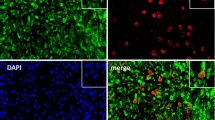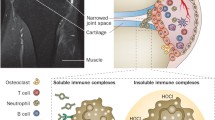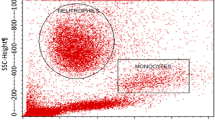Abstract
Oxidative damage caused by oxygen free radicals from activated phagocytes contributes to the pathology of arthritis. The present study evaluates the activity of NADPH oxidase of neutrophils and monocytes from patients suffering from various inflammatory and autoimmune rheumatic diseases. Production rates of reactive oxygen species [ROS] of neutrophils and monocytes from rheumatic patients are compared to those of healthy controls and non-rheumatic disease controls and correlated with the plasma levels of tumor necrosis factor alpha, C-reactive protein and the sedimentation rates of erythrocytes. There was a two- to eightfold increase in phagocytic superoxide production in rheumatic patients, when compared to healthy subjects or patients with non-rheumatic internal diseases [p<0.005]. The enhanced NADPH oxidase-dependent Superoxide generation correlated well with elevated levels of tumor necrosis factor alpha [TNF-α] in plasma [p=0.005], suggesting a causal relation. There was no correlation with the plasma levels of C-reactive protein and a weak though significant correlation with the sedimentation rates of erythrocytes [p=0.043]. Removal of circulating TNF-α by dialysis of patients' blood and inhibition of NADPH oxidase by prednisolone treatment normalized elevated ROS production to the levels of healthy controls and correlated with the clinical improvements. Our data support the hypothesis of a central role for TNF-α during the development of arthritis. The chemiluminescence assay described here may be useful as a convenient screen and as a potential follow up procedure for individual patients with rheumatic diseases.
Similar content being viewed by others
References
Rossi, F. 1986. The O −2 forming NADPH oxidase of the phagocytes: nature, mechanisms of activation and function.Biochim. Biophy. Acta 853:65–89.
Miesel, R., andM. Zuber. 1993. Reactive nitrogen intermediates, antinuclear antibodies and copper-thionein in serum of patients with rheumatic diseases.Rheumatol. Int. 13:95–102.
Babior, B. M., J. T. Curnutte, andB. J. McMurrich. 1976. The paniculate superoxide-forming system from human neutrophils. Properties of the system and further evidence supporting its involvement in the respiratory burst.J. Clin. Invest. 58:989–996.
De Sole, P. 1992. Recent developments in clinical applications of cellular luminescence.In: P. E. Stanely, and L. J. Krick, editors. Bioluminescence and Chemiluminescence. Wiley, New York, pp. 245–252.
Gupta, J. W., M. Kubin, L. Hartman, M. Casatella, andG. Trinchieri. 1992. Induction of expression of genes encoding components of the respiratory burst oxidase during differentiation of human myeloid cell lines induced by tumour necrosis factor and gamma-interferon.Cancer Res. 52:2530–2537.
Utsumi, T. J., K. Klostergaard, K. Akimaru, E. F. Edashige, L. Sato, andK. Utsumi. 1992. Modulation of TNF-alpha-priming and stimulation-dependent superoxide generation in human neutrophils by protein kinase inhibitors.Arch. Biochem. Biophys. 294:271–278.
Beutler, B., andA. Cerami. 1989. The biology of cachectin/TNF: a primary mediator of the host response.Annu. Rev. Immunol. 7:625–655.
Fiers, W. 1989. Tumor necrosis factor. Characterization at the molecular, cellular and in vivo level.FEBS Lett. 285:199–212.
Beutler, B. 1992. Tumor necrosis factors:In: The molecules and their emerging role in medicine. Raven Press, New York.
Tetta, C., G. Camussi, V. Modena, C. Di Vittoria, andC. Baglioni. 1990. Tumor necrosis factor in serum and synovial fluid of patients with active and severe rheumatoid arthritis.Ann. Rheum. Dis. 49:665–667.
Aloe, L., L. Probert, G. Kollias, L. Bracci-Laudieri, M. G. Spillantini, andR. Levi-Montalcini. 1993. The synovium of transgenic arthritic mice expressing human tumor necrosis factor contains a high level of nerve growth factor.Growth Factors 9:149–155.
Gyllenhammar, H. 1987. Lucigenin chemiluminescence in the assessment of neutrophil superoxide production.J. Immunol. Meth. 97:209–213.
Blair, A. L., L. A. Cree, J. S. Beck, andJ. G. M. Hastings. 1988. Measurement of phagocyte chemiluminescence in a microtitre plate formate.J. Immunol. Meth. 112:163–168.
Newburger, P. E., H. J. Cohen, S. B. Rothschild, J. C. Hobbins, S. E. Malawiste, andM. J. Mahoney. 1979. Prenatal diagnosis of chronic granulomatous disease.N. Engl. J. Med. 300:178–181.
Fisher, A., P. H. Trung, B. Descamps-Latscha, I. Lisoska-Grospierre, L. Gerota, N. P. Perez, C. Scheinmetzler, A. Durandy, J. L. Virelizier, andC. Griselli. 1983. Bone marrow transplantation for inborn error of phagocytic cells associated with defective adherence, chemotaxis, and oxidative response during opsonised particle phagocytosis.Lancet 2:473–476.
Root, R. K., A. S. Rosenthal, andD. J. Balestra. 1972. Abnormal bactericidal metabolic and lysosomal functions of Chediak-Higashi syndrome leukocytes.J. Clin. Invest. 51:649–658.
Riordan, J. R., J. M. Rommers, andB. S. Kerem. 1989. Identification of the cystic fibrosis gene: cloning and characterization of complementary DNA.Science 245:1067–1072.
De Simone, C., P. De Sole, G. Di Marco, A. Venier, D. Cerimele, andF. Serri. 1989. Reactive oxygen species production in circulating polymorphonuclear leukocytes in psoriasis.146:50–52.
Fromtling, R. A., andG. K. Abruzzo. 1985. Chemiluminescence as a tool for the evaluation of antimicrobial agents: a review.Meth. Find. Exp. Clin. Pharmacol. 7:493–500.
Bloomfield, F. J., andM. M. C. Young. 1988. Enhanced chemiluminescence production by phagocytosing neutrophils in psoriasis.Inflammation 12:153–159.
Marhoffer, W., M. Stein, E. Keck, andK. Federlin. 1993. Chemilumineszenzinduktion und Funktion neutrophiler Granulozyten bei rheumatoider Arthritis-eine vergleichende Studie.Kassenarzt 52:26–27.
Miesel, R., M. Zuber, D. Sanocka, R. Grätz, andH. Kröger. 1994. The effects of allopurinol in the in vivo suppression of arthritis in mice and the ex vivo modulation of the phagocytic production of oxygen radicals in whole human blood.Inflammation 18:597–611.
Kelley, W. N., E. P. Harris, Jr., S. Ruddy, andC. B. Sledge. 1989.In Textbook of Rheumatology, Saunders, Philadelphia.
Fox, R. J., C. A. Robinson, J. A. Curd, F. Kozin, andF. V. Howell. 1986. Sjoegren's syndrome. Proposed criteria for classification.Arthritis Rheum. 29:577–585.
Tan, E. M., A. S. Cohen, J. F. Fries, A. T. Masi, D. J. McShane, N. F. Rothfield, J. Schaller, N. Talal, andR. J. Winchester. 1982. The 1982 revised criteria for the classification of systemic lupus erythematosus.Arthritis Rheum. 25:1271–1277.
Arnett, F. C., S. M. Edworthy, D. A. Bloch, D. J. McShane, J. E. Fries, N. S. Cooper, L. A. Healey, S. R. Kaplan, M. H. Liang, H. S. Luthra, T. A. Medsger, Jr., D. M. Mitchell, D. H. Neustadt, R. S. Pinals, J. G. Schaller, J. T. Sharp, R. L. Wilder, andG. G. Hunder. 1987. The American Rheumatism Association 1987 revised criteria for the classification of rheumatoid arthritis.Arthritis Rheum. 13:315–324.
Miesel, R., N. Ulbrich, H. Kröger, andA. Mitchison. 1995. Assessment of collagen type II induced arthritis in mice by whole blood chemiluminescence.Autoimmunity 19:153–159.
Duff, G. W. 1994. Cytokines and acute phase proteins in rheumatoid arthritis.Scand. J. Rheumatol. 23:9–19.
van den Hoogen, H. M. M., B. W. Koes, J. T. M. van Eijk, andL. M. Bouter. 1995. On the accuracy of the history, physical examination, and erythrocyte sedimentation rate in diagnosing low back pain in general practice: A criteria-based review of the literature.Spine 20:318–327.
Allen, R. C. 1982. Biochemiexcitation: chemiluminescence and the study of biological oxygenation reactions.In Chemical and Biological Generation of Excited States. W. Adam and P. Cilento, editors. Academic Press, New York, pp. 309–344.
Breedveld, F. 1994. Tenidap: A novel cytokine-modulating antirheumatic drug for the treatment of rheumatoid arthritis.Scand. J. Rheumatol. 23:31–44.
Kushner, I., and A.Mackiewicz. Acute phase proteins as disease markers.Dis. Markers 5:1–21.
Miesel, R., M. Zuber, R. Hartung, R. Haas, andH. Kröger. 1995. Total radical-trapping antioxidative capacity of plasma and whole blood chemiluminescence in patients with inflammatory and autoimmune rheumatic diseases.Redox Report 1:323–330.
Miesel, R., andM. Zuber. 1993. Copper-dependent antioxidase defenses in inflammatory and autoimmune rheumatic diseases.Inflammation 17:283–294.
Miesel, R., M. Kurpisz, andH. Kröger. 1995. Modulation of inflammatory arthritis by inhibition of poly[ADP-ribose]polymerase.Inflammation 19:379–387.
Elliott, M. J., R. M. Maini, M. Feldmann, A. Long-Fox, P. Charles, andF. M. Brenan. 1993. Treatment of rheumatoid arthritis with chimeric monoclonal antibodies to TNFα. Safety, clinical efficacy and regulation of the acute phase response.Brit. J. Rheumatol. 32:209–216.
Schreck, R., K. Albermann, andP. A. Baeuerle. 1992. Nuclear factorκB: an oxidative stress-responsive transcription factor of eukaryotic cells [a review].Free Radic. Res. Commun. 17:221–237.
Lenardo, M. J., andD. Baltimore. 1989. NF-κB: a pleiotropic mediator of inducible and tissue-specific gene control.Cell 58:227–229.
Stocker, R., andB. Frei. 1991. Endogenous antioxidant defences in human blood plasma.In Oxidative stress, oxidants and antioxidants. H. Sies, editor. London, Academic Press, 213–243.
Roederer, M., F. J. T. Staal, P. A. Raju, W. Ela, L. A. Herzenberg, andL. A. Herzenberg. 1990. Cytokine-stimulated human immunodeficiency virus replication is inhibited by N-acetyl-L-cysteine.Proc. Natl. Acad. Sci. U.S.A. 87:4884–4888.
Miesel, R., D. Sanocka, M. Kurpisz, andH. Kröger. 1995. Anti-inflammatory effects of NADPH oxidase inhibitors.Inflammation 19:347–362.
Miesel, R., andR. Haas. 1993. Reactivity of an active center analogue of Cu2Zn2 superoxide dismutase in a murine model of acute and chronic inflammation.Inflammation 17:595–611.
Miesel, R., A. Dietrich, B. Brandl, M. Kurpisz, andH. Kröger. 1994. The phagocytic suppression of proinflammatory responses by an active center analogue of Cu2Zn2 superoxide dismutase modulates the onset, progression and remission of arthritis.Rheumatol. Int. 14:119–126.
Author information
Authors and Affiliations
Rights and permissions
About this article
Cite this article
Miesel, R., Hartung, R. & Kroeger, H. Priming of NADPH oxidase by tumor necrosis factor alpha in patients with inflammatory and autoimmune rheumatic diseases. Inflammation 20, 427–438 (1996). https://doi.org/10.1007/BF01486744
Issue Date:
DOI: https://doi.org/10.1007/BF01486744




